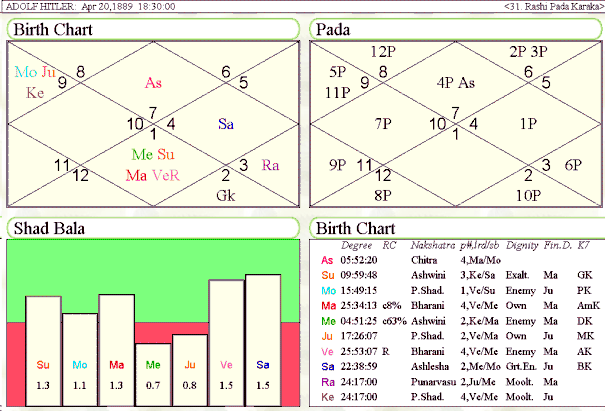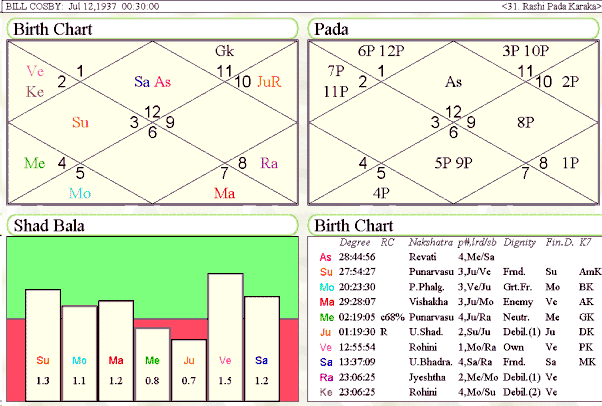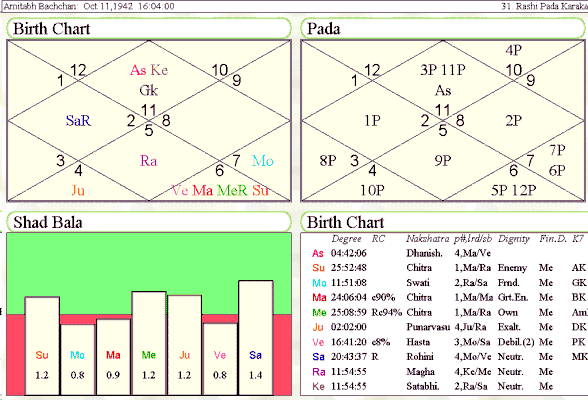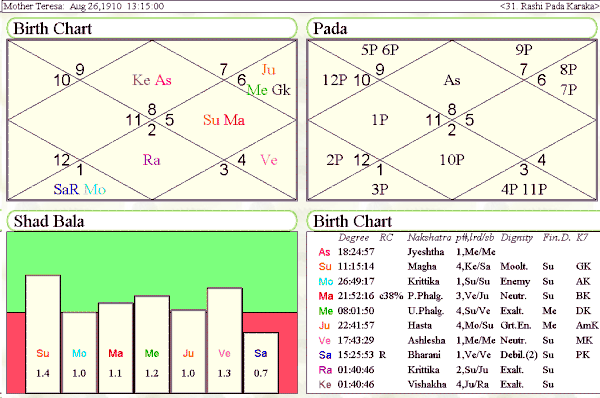Dec 24, 2025
Dec 24, 2025
Some years ago, I read about what was described as 'maya-pada' in writer astrologer Sanjay Rath's postings made on one of the jyotish list. Thereafter, I read about it again in articles written by his student Narasimha Rao and it reappeared also in the latter's textbook, which by the way, is a very well organized presentation for students of jyotish. Getting back to the issue at hand, in this article the concept and associated technical items will be briefly described for those who are not familiar with these.
Maya or illusion is really more of a delusion than an illusion! A delusion is a thought or idea which is not based on observed or perceived reality (e.g., the ghost that lives on the peepul tree in a village - never actually seen by anyone, but of course everyone "knows" it is up there). On the other hand, an illusion is the misperception of an 'object' (mistaking a rope for a snake, for instance).
Spiritualists of ancient and modern times have stated that as we live through our earthly human existence, each of us acquires a personal view of reality. There is often a discrepancy between the absolute reality and what we perceive it to be. This leads to a subjective mis-interpretation of the universe, resulting in our giving more importance to things which obviously are evanescent and impermanent. We chase after those things throughout our life, which we are certainly forced to leave behind when we die and can never bring back with us when we are reborn. We fall in love and become attached to objects, ideas and persons, a liaison based on whims and fancies, to be frustrated and saddened when things do not work out and that leads to disillusionment when glimpses of reality finally dawn upon us. Maya also leads to generation of actions that are also known as 'karma' and which then take over the reins of our destiny, thus, becoming the charioteer of our spiritual vehicle on this path of spiritual progress that is our soul-goal and the sole reason for our being in this earthly reality.
We often run into individuals who have led quite accomplished lives in our eyes but when they confide in someone, those confidantes would tell us a different story. The individual may actually think of himself as an utter failure! Between the admired role model and us the follower, at least one of us is obviously not tapped into 'reality' and hence we see the duality which is a consequence of maya. We might judge someone as very brave or very pious, but in reality, they might be very ordinary and quite petty actually.
If our horoscopes are to reflect the different facets of the human experience, then there should be a clear way of discerning the fact that the subjective perceptions of the nativity do not (or do) match the observed reality (which may in turn be different from absolute reality which one can figure out only through the knowledge of things that transcend earthly knowledge!).
In a horoscope, we have twelve houses and nine planetary indicators (5 planets, 2 lights and 2 nodes). These obviously are not adequate for covering all facets of modern human life. Jyotish, therefore, must use a variety of indicators known as karakas or executors. There are three types of karakas described by Parashara: inherent (naisargika) karakas, fixed (sthira) and transitional (chara) karakas. The latter are also utilized extensively in the Jaimini system which some individuals insist is a separate system and must not be mixed with the mainstream Parashari system. Despite the strength of expression in these statements, such a tight water-tight compartmentation has not been adequately demonstrated and remains a subjective opinion, like many such others that abound in Jyotish. I find it difficult to visualize that the same planet puts on its Parashari cap when looking at (aspecting) another planet, but would then take it off to put on its Jaimini cap to indicate its chara dashainfluence or chara karaka role!
There are also several secondary houses described in jyotish. There is the 'bhavat-bhavam' concept, a term which a sanskritologist claimed to be grammatically incorrect. The concept, regardless of its linguistic accuracy or purity, is what I have called 'the Vedic hopscotch'. The secondary house is located as many houses from the house under consideration, as the house is away from lagna or first house. So, 3rd house is the bhavat-bhavam house for 2nd, 7th is bhavat-bhavam for 4th, 7th is bhavat-bhavam for 10th, etc. So, if the lord of first house is in the 2nd house then the house secondarily describing the 2nd house attributes will be the third house.
One commonly used utilization of this system of house arrangement is in determining longevity. The primary house for longevity is the 8th house, the 3rd house which is 8th from the 8th is used as a secondary house for longevity and the two houses that represent loss of longevity by being 12th from 8th and 3rd, i.e., the 7th and 2nd represent the killers or maraka houses. In the bhavat-bhavam arrangement, the secondary house can ONLY be in an odd house from lagna! The symbolic 'yang' aspect in terms of doing, action, execution are male attributes which is represented in astrology as the odd house, the odd sign. Do the bhavat bhavam houses represent the influences and indicators that express the results of the primary houses under consideration? For example, the 3rd (effort, action) leads to replenishing of and provision to 2nd house (family, wealth), the fifth house (creativity, children) being the motivators for action (3rd house), ones bhagya, 9th (bhavat bhavam of 5th) being the determinator for fructification of the 5th house (future karma, children). The two lords, that ruling the primary house and the secondary or bhavat-bhavam house must be in harmony for the primary house to fructify fully and harmoniously. There might be some other deep significance lying within this arrangement as well, but let us move Back to the topic at hand.
Another very popular (more so now than some 30-40 years ago) way of determining the secondary indicators is through using the (Jaimini) padas [also described by Parashara]. Since both Parashara and Jaimini had not mentioned each other in their texts (though Parashara mentions Lord Buddha when describing the planetary representations of avatars - unless this was transplanted later on into BPHS), conflicting views exist as to who came earlier, of these two astrological giants, so it is hard to figure out if Parashara was quoting Jaimini or vice versa. Be that as it may, the padas of a house are calculated in a manner vaguely reminiscent of the bhavat bhavam. If the lord of first house is in the 2nd house and hence one house removed from the first house, the bhavat bhavam and pada will both fall in the 3rd house which is one house removed from the 2nd house, the location of lord of first house in this case. The pada takes into account the placement of the lord and hence is horoscope specific, whereas, bhavat bhavam is fixed (like the fixed karakas) for all charts. As another example, if lord of lagna is in the fifth house then pada or arudha will fall in the fifth from the fifth house, or ninth house. If in the sixth house, the arudha will fall in the 11th house (6th from 6th) and so on.
The pada of lagna (1st house) is called aroodha or image (according to Sanjay's translation). This image or reflection is an important concept to grasp. What we are being told here is that the aroodha or lagna-pada is the 'image' of the first house, as seen by others. This is important to understand, because it links directly to the 'perception' aspect in how others perceive our 'image'. The lagna, in this case, then would be the 'true' reality, whereas, the lagna-pada will be the picture of this true reality, as perceived by the world. Just to briefly touch upon how the nativity will see the true reality, according to Narasimha, would be judged from the graha-pada(details given in his writings, but not discussed in this article). An effective alternative to this indicator of the personal reality view is studying the lagna-oriented house from the lagna lord (dispositors of the lagna and moon, for better definition of the view, a future article perhaps!).
Since the image cannot fall in the same house the pada for which is being considered, as well as in the 7th house there from, hence, Parashara (and Jaimini) have recommended that the pada be moved to the tenth house from the obvious pada. So, if a planet is placed in its own house or in the 7th house there from, the pada will not fall in the same house but in the tenth house, there from. Likewise, if a planet is in the 4th or 10th house from its own (giving the pada in 7th house; fourth from fourth or tenth from tenth, from the house under consideration), the pada will be considered to be in the tenth house from the seventh, ergo, in the fourth house in the case of lagna pada with lagnesha in fourth or tenth house from lagna. This exception is recognized and used by a large majority of astrologers, however, one of contemporary writers, K.N. Rao in his book has advised against this, without giving further elaboration or explanations.
The pada of each house, therefore, represents its image or reflection as perceived by others. Simply put, if the 2nd pada is strong, your family life, your wealth and your expression will be perceived by others as effective, strong, positive in your life, even giving others cause for envy, etc. If the pada of tenth is weak or afflicted by aspect or association with malefics, your good work will simply not leave a mark on others when they judge you; on the other hand, if the pada of tenth is very strong and fortified by benefic influences, then even your half-hearted attempts would be perceived by others as great pieces of work that helped humanity ... etc. Most of us have mixed influences and end up with half the world extolling our virtues while the other half cannot wait to drag us through mud! And all of this can change with the dashas as they change during our life.
It must be immediately apparent that the (maya) pada, while operable in the lives of each of us, would be extremely important for those who lead a public life. The celebrities, politicians, administrators, need a strong pada in order to be charismatically effective and to be considered effective and successful in what they are trying to do. Spiritual leaders, also are very vulnerable to public opinions, scrutiny and so the pada influences their lives and work, considerably.
Very few would perceive Hitler as anything but a devil-driven tyrant, someone with a mission to force a new form of world-order through means of destruction, terror, tyranny, confinement, etc. Not quite the image that would fit the Libra rising, with Venus, retrograde (retrograde benefics improve in their benefic properties), and despite the 'cruel' influence of mars and exalted sun (megalomania in its worst possible expression), the hideous picture does not quite gel. If we examine the pada chart, his lagna pada (aroodha) is falling in the 10th house, right where a strong Saturn is placed in cancer. Saturn is bhratri karaka and is placed in a very inimical sign. Others would perceive him as an enemy, someone to be feared, someone who arrived with a mission to uplift the masses, to teach society a lesson, through the harshest expression of power. He probably thought that he was 'caring' for his people, strengthening the destiny of Germany and Germans (gajakeshari in ninth from lagnesha but with ketu), but most others do not perceive him that way.


Bill Cosby, the quintessential 'father' of modern times, has his lagna pada placed in the ninth house, the house that represents father and in doing so sits smack on rahu, the indicator of images and film/television! Rahu represents mars in this chart (since it occupies Scorpio), hence the somewhat 'cutting' edge to his ironical, satirical humor, the wry, tough-love approach. Mars is also the atmakaraka, by the way, hence fits in the picture well. Mercury, the patron lord of comedians casts aspect on aroodha from the 5th house (entertainment, children). Bill is very natural with children, as seen in his television sitcoms and shows.
The lord of fifth in 6th, the lord of 2nd in 8th, Jupiter aspecting from 11th, the fifth house (partial cancellation due to angular Saturn), are not good indications for family in personal life (his son was killed a few years ago). Perhaps saptamamsha will give more indications of this. This chart is a good example of how deceiving exaltation can be when considered as a sole factor (sometimes done because of the obvious convenience). In V7 saptamesha, Jupiter is exalted (retrograde) in 5th house. However, it is weak in shadbala and the putrakaraka Venus is placed in the 12th house (loss). The 5th pada falls in the 3rd house with gulika in it. Lord of fifth, moon is placed in 7th (in Jaimini aspect) from 8th pada (maranapada), again not good for longevity of children. Such is the maya!
Speaking of 'maya' and particularly of screen personalities and their maya, we cannot but skip past the phenomenal super-star of Bollywood, Mr. Angry Young Man, Amitabh Bachchan, the heart-throb of my generation and at least one more after mine! His intense, on-screen persona and his immense acting skills that added to his range going from the almost schizoid poet in Saat Hindustani to his role in Zanzeer and the contrasting bubbly roles in other movies have won many a hearts. Before he became the Lovable Mr. Lamboo from whom the public will take anything, he was brought to notice by his intense, nearly silent roles.

Amitabh Bachchan's lagna pada is in the 4th house smack on the Saturn which is retrograde in Taurus and also lagnesha! Is that the key? His arudha sits on his lagnesha that is the strongest planet in the chart! His screen persona is very genuine and convincing! People just feel that they are experiencing the real Mr. Bachchan and not some conjured up screen image! His phenomenal rise during his Saturn dasha is not some happenstance. October 2003 onwards, gnatikaraka dasha will begin and he may find himself amongst those who are ambitious, not as accomplished but younger stars. He has of course wisely moved on to other things, already!
Martha Stewert whose name and options have recently withstood a severe public damage has her lagna pada in 9th house giving that wholesome image of traditional living for many seasons. With cancer chara dasha beginning in August 2002, she has had to see significant losses in business assets and experienced inimical activity (2nd and 6th pada is in cancer in 10th house and contains gnatikaraka mercury and bhratrikaraka sun - indicating an associate who might have brought attention to her dealings). In dashamsha, lagna pada lord mars is in debility in 4th house across from moon and Venus (lords of 4th, 2nd and 7th) and has brought loss and defamation to some extent.
Moving along to the next chart; a saint unquestionably, but it would be correct to say that this saint was perceived by all as one who knew how to serve God through serving humanity. A true mother, is it any surprise that the lagna arudha is placed in the fourth house as she created homes and resting places (4th) for many weary souls and looked after them with selfless love as only a mother can. Her spirituality was of genuine love and sacrifice and little wonder that the pada of 9th house falls in the 12th house just where Venus is placed. Giving birth to an institution of love and caring. Venus, additionally, is the matrukaraka in this horoscope. Her life was not easy and the presence of gnathikaraka sun (in strength) with the third karaka (bhratrikaraka mars) in 10th house is indicative of this self-chosen life of sacrifice, service and efforts. this was no airy-fairy saint, but a down to earth and practical angel, sent to the slums of Calcutta to uplift the human spirit and to thus earn her wings.

That atmakaraka moon (natural karaka for mother) is in Aries in 6th with debilitated Saturn is not accidental but indicative of her self-chosen mission. That retrograde Saturn happens to be putrakaraka is significant too in this symbol of motherhood divine that her life represents. Sun is the lord of 10th and very strong. It is also gnatikaraka and hence cannot promise luxuries and comfort. Atmakarak moon is in its nakshatra and so the life was intended to be hard and even harsh. Sun is also the final dispositor of several planets and this again indicates that despite all the pain and self-denials, this individual will attain world reknown and she did. Tenth pada in 7th house hardly is capable of keeping the real worth hidden! So the saint comes to light, and finds her work just as it was intended (dashamesh in 10th with lagnesha placed therein) with full personal involvement, though others may see this as being enacted in a far-off land in a culture that was not her own (10th pada in 7th house where rahu is placed).
Astrology writers tend to depict in their writings, almost in an unsaid manner, and sometimes overtly - as if the rules of astrology are rigid and work perfectly each time. However, it is not always true and even after weeding out inaccurate birth times, ayanamshas and other factors, each astrologer would personally experience difficult charts. Difficult because the rules of astrology do not work predictably in those cases, despite all corrections and fixing and tweaking humanly and honestly possible. These charts provide one an opportunity to stop and wonder if there is something even beyond the ignorance of the astrologer as well as beyond the perfection of astrology, that may need to be accounted for from time to time. With that always kept in the back of one's mind, when indications behave in a predictable manner, it gives one the satisfaction and reason to continue pursuing astrology as a tool for useful advice. And, when one gets stymied by the 'difficult' unrelenting charts, this gives one the reason to pursue even further with eyes opened wider and the mind energized by this challenge that destiny posed before us or perhaps it is a case where the expression of freedom of choice has challenged the drums of destiny!
Please do not post reading requests in the comments section here. ONLY comments on the contents of this article are welcome here. If you wish to order an astrological session (SKYPE Interactive Only!) with Rohiniranjan - Click here
16-May-2004
More by : Rohini Ranjan